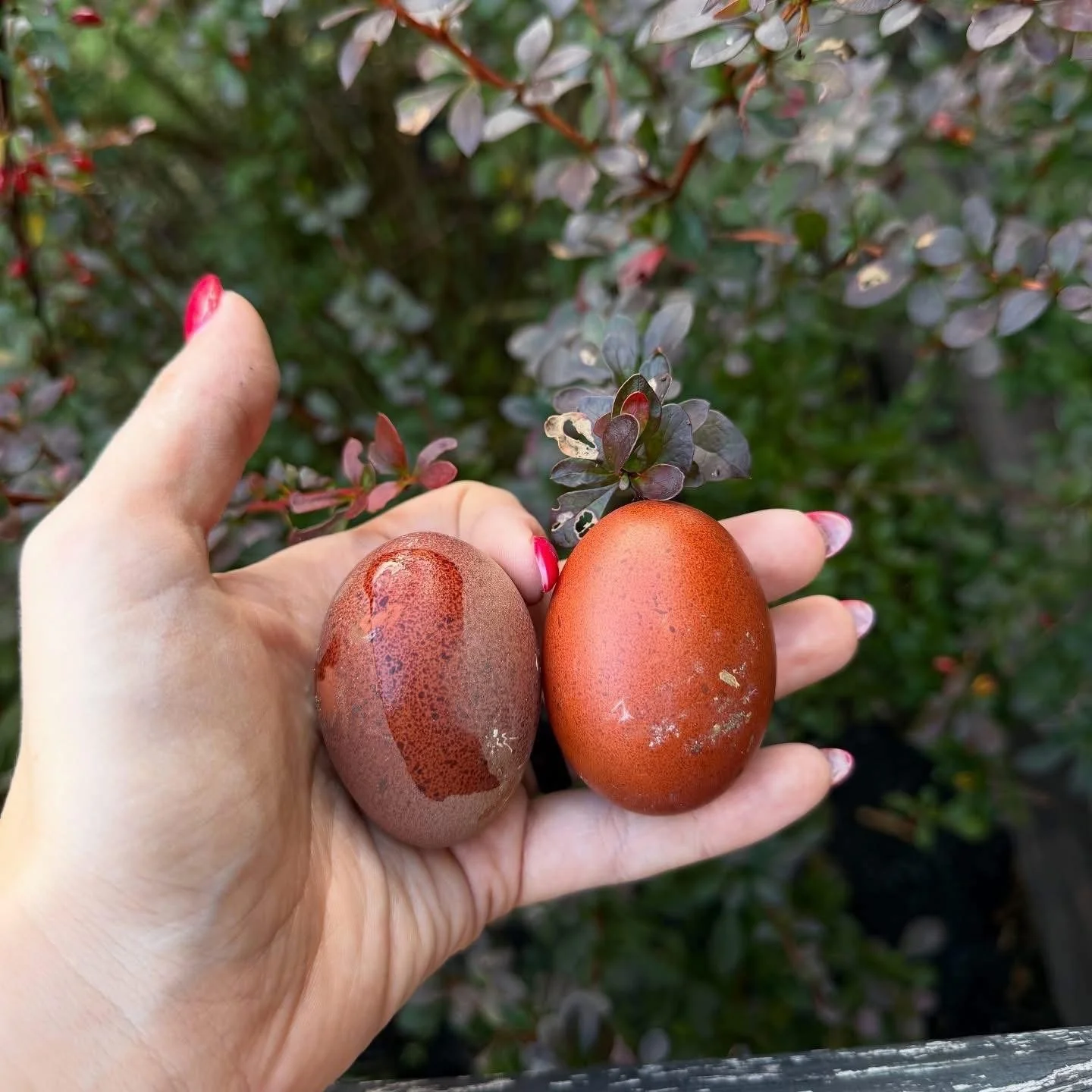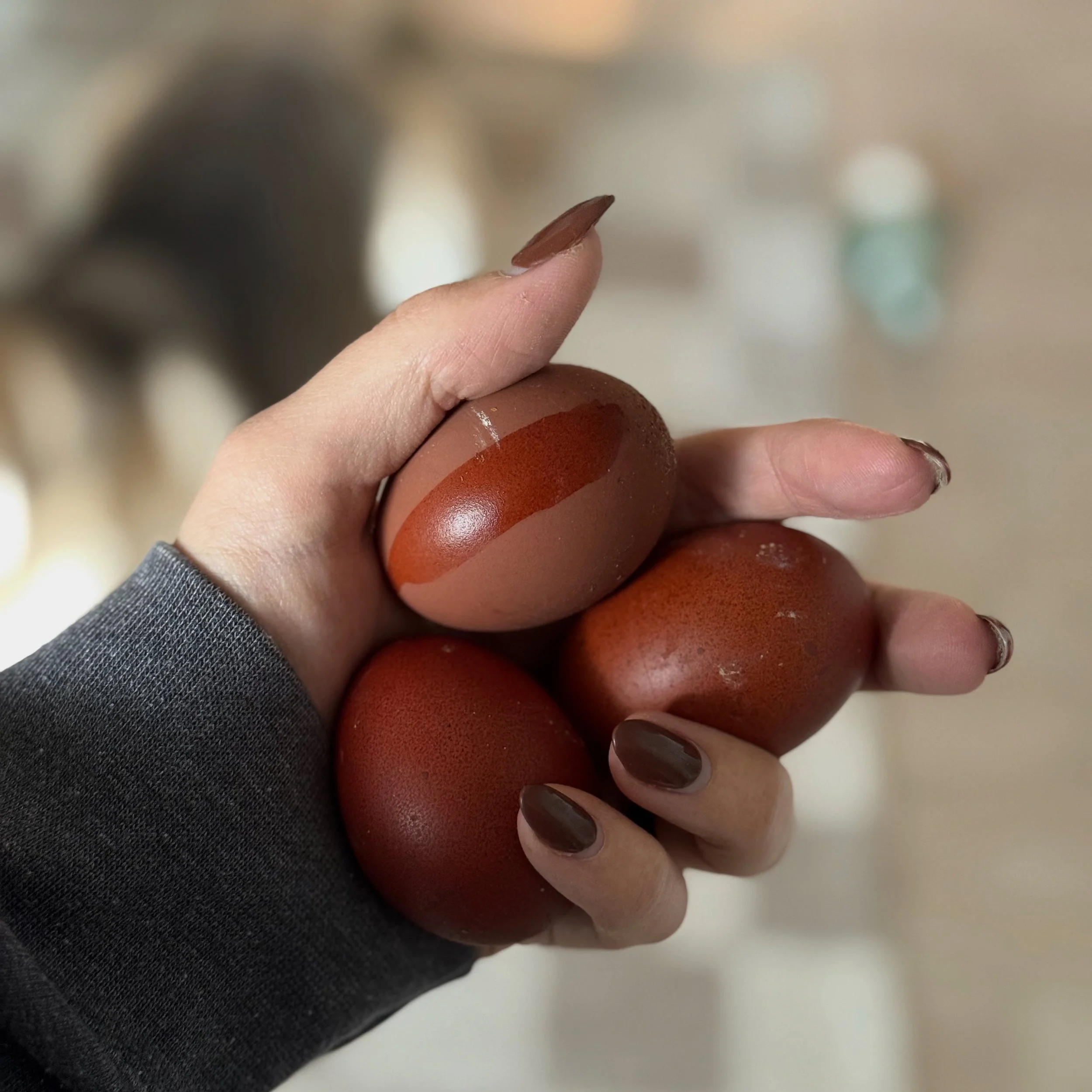 Image 1 of 4
Image 1 of 4

 Image 2 of 4
Image 2 of 4

 Image 3 of 4
Image 3 of 4

 Image 4 of 4
Image 4 of 4





Heavy Bloom Marans
PRE-ORDERS FOR 2026 WILL BEGIN JANUARY 1 - Shipping will start in March and go through June. You’ll receive an email confirmation when your order ships. Please include any weeks you won’t be able to receive the order.
We’re thrilled to release our Heavy Bloom line for the upcoming 2026 season. This breeding group was selected for hens that lay deep, chocolate-colored eggs often topped with a soft, hazy “bloom” coating that can range from in shades from mauve, purple, periwinkle and dusty rose.
These are from our purebred black copper marans. We have the heavy blooms carriers set up in a separate coop with their very own rooster.
Our current rooster hatched from a beautiful level 8 egg with a heavy bloom, so the genetics are in place for that beautiful finish—though nature will always add her own touch.
Important: Not every egg will show a bloom, as the trait can vary between hens and across the laying cycle. You’ll receive 6 hatching eggs from this pairing. Orders are limited to one set per customer; any additional sets will be refunded and cancelled. You will be refunded the total MINUS the credit card fee.
Please review our shipping policies prior to making a purchase.
PRE-ORDERS:
For Spring 2026, we will be taking pre-orders which is essentially a “wait-list”. The goal is for us to ship eggs between March and June. We WILL NOT send an email prior to shipping the eggs, so please have an incubator ready between those time frames. We have in the past, but it’s been hard when people cannot accept eggs and it really does mess up our organization. We hope to find a better way in the future.
TIME FRAMES:
You will be given an estimated time frame of about 12 weeks which your order could ship between. Due to nature, this might change but you will be given an email notice with option for a refund if you do not want to wait. We do not plan on taking more orders than our farm can handle.
📦 Return & Refund Policy – Hatching Eggs
Due to the nature of hatching eggs, all sales are final. We do not accept returns or offer refunds once your order has been shipped, or after 24 hours from purchase. If you do need to cancel your order within 24 hours of purchase, you’ll be issued a store credit for future use. We guarantee that all eggs are fresh and fertile at the time of shipping. We do not replace or refund broken eggs, please file a claim with USPS. Please remember that just because an egg did not develop during incubation, DOES NOT MEAN it was not fertile. So many factors can play a role in hatch rate and development.
Fertility is regularly monitored from each breeding pen to ensure roosters are actively doing their job. That said, once eggs are handed off to USPS, we are no longer responsible for their handling, delays, or damage. Standard shipping is via USPS Priority Mail (1–3 days) and includes $100 of insurance (shipping fees are not covered under this insurance).
If your package arrives damaged, please:
Take clear photos of the box, packaging, and any broken eggs
Inspect your package immediately upon pickup
File a damage claim with USPS online (damage only, not shipping delays)
Send us pictures and video evidence within 24 hours of arrival
Please remember: Hatching eggs are always a gamble. We cannot guarantee hatch rates or how USPS handles the eggs during transit.
If we are unable to fulfill your order for any reason on our end, you will receive a refund. For any concerns, feel free to contact us via email or Facebook.
🚚 Shipping Info
We ship all hatching eggs via USPS Priority Mail (1–3 days) with $100 insurance included. Please note:
Delivery times are estimated, not guaranteed
USPS insurance covers damage, but not delays
Once the package is accepted by USPS, we cannot control how it is handled
We do our best to:
Carefully package each box to protect your eggs
Clearly label boxes to indicate fragile contents
Request USPS hold your package for pickup (please leave your phone number at checkout). This is a request, not a guarantee.
If your order exceeds $100, USPS only covers that amount under standard insurance. You may email us to request additional coverage at an extra cost.
All tracking information will be emailed once your order ships. Please inspect your box upon pickup and file claims with USPS directly for any issues.
PRE-ORDERS FOR 2026 WILL BEGIN JANUARY 1 - Shipping will start in March and go through June. You’ll receive an email confirmation when your order ships. Please include any weeks you won’t be able to receive the order.
We’re thrilled to release our Heavy Bloom line for the upcoming 2026 season. This breeding group was selected for hens that lay deep, chocolate-colored eggs often topped with a soft, hazy “bloom” coating that can range from in shades from mauve, purple, periwinkle and dusty rose.
These are from our purebred black copper marans. We have the heavy blooms carriers set up in a separate coop with their very own rooster.
Our current rooster hatched from a beautiful level 8 egg with a heavy bloom, so the genetics are in place for that beautiful finish—though nature will always add her own touch.
Important: Not every egg will show a bloom, as the trait can vary between hens and across the laying cycle. You’ll receive 6 hatching eggs from this pairing. Orders are limited to one set per customer; any additional sets will be refunded and cancelled. You will be refunded the total MINUS the credit card fee.
Please review our shipping policies prior to making a purchase.
PRE-ORDERS:
For Spring 2026, we will be taking pre-orders which is essentially a “wait-list”. The goal is for us to ship eggs between March and June. We WILL NOT send an email prior to shipping the eggs, so please have an incubator ready between those time frames. We have in the past, but it’s been hard when people cannot accept eggs and it really does mess up our organization. We hope to find a better way in the future.
TIME FRAMES:
You will be given an estimated time frame of about 12 weeks which your order could ship between. Due to nature, this might change but you will be given an email notice with option for a refund if you do not want to wait. We do not plan on taking more orders than our farm can handle.
📦 Return & Refund Policy – Hatching Eggs
Due to the nature of hatching eggs, all sales are final. We do not accept returns or offer refunds once your order has been shipped, or after 24 hours from purchase. If you do need to cancel your order within 24 hours of purchase, you’ll be issued a store credit for future use. We guarantee that all eggs are fresh and fertile at the time of shipping. We do not replace or refund broken eggs, please file a claim with USPS. Please remember that just because an egg did not develop during incubation, DOES NOT MEAN it was not fertile. So many factors can play a role in hatch rate and development.
Fertility is regularly monitored from each breeding pen to ensure roosters are actively doing their job. That said, once eggs are handed off to USPS, we are no longer responsible for their handling, delays, or damage. Standard shipping is via USPS Priority Mail (1–3 days) and includes $100 of insurance (shipping fees are not covered under this insurance).
If your package arrives damaged, please:
Take clear photos of the box, packaging, and any broken eggs
Inspect your package immediately upon pickup
File a damage claim with USPS online (damage only, not shipping delays)
Send us pictures and video evidence within 24 hours of arrival
Please remember: Hatching eggs are always a gamble. We cannot guarantee hatch rates or how USPS handles the eggs during transit.
If we are unable to fulfill your order for any reason on our end, you will receive a refund. For any concerns, feel free to contact us via email or Facebook.
🚚 Shipping Info
We ship all hatching eggs via USPS Priority Mail (1–3 days) with $100 insurance included. Please note:
Delivery times are estimated, not guaranteed
USPS insurance covers damage, but not delays
Once the package is accepted by USPS, we cannot control how it is handled
We do our best to:
Carefully package each box to protect your eggs
Clearly label boxes to indicate fragile contents
Request USPS hold your package for pickup (please leave your phone number at checkout). This is a request, not a guarantee.
If your order exceeds $100, USPS only covers that amount under standard insurance. You may email us to request additional coverage at an extra cost.
All tracking information will be emailed once your order ships. Please inspect your box upon pickup and file claims with USPS directly for any issues.

